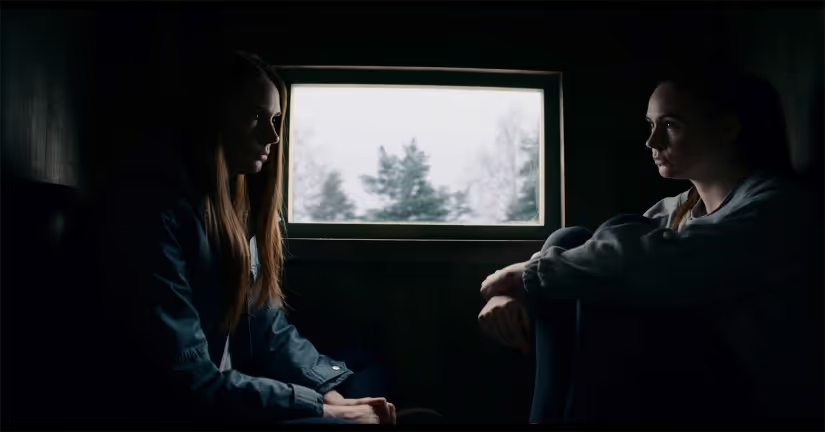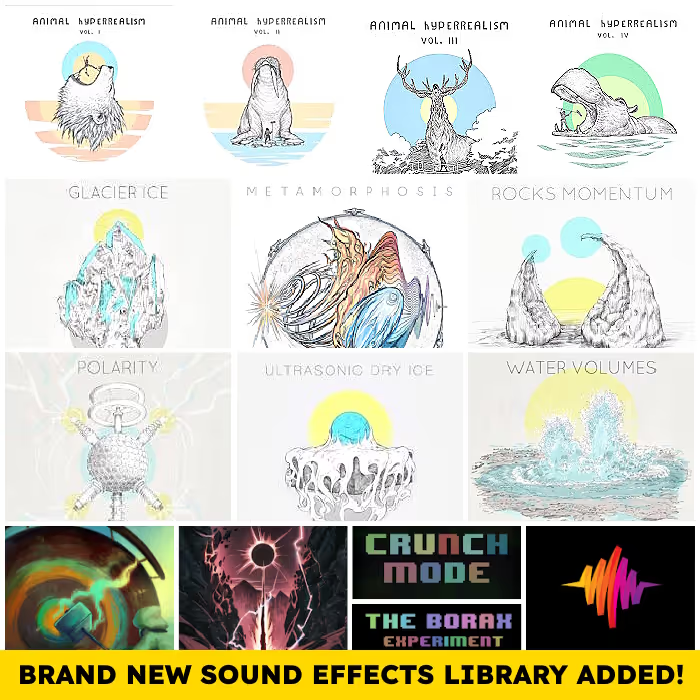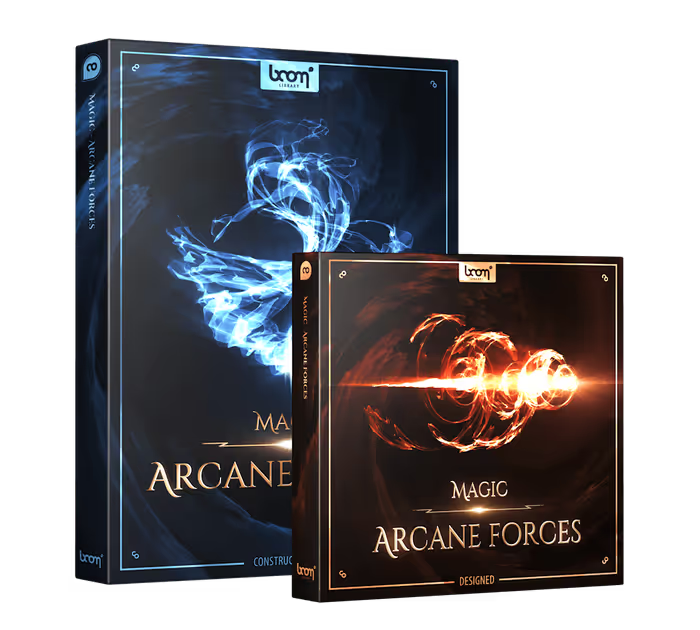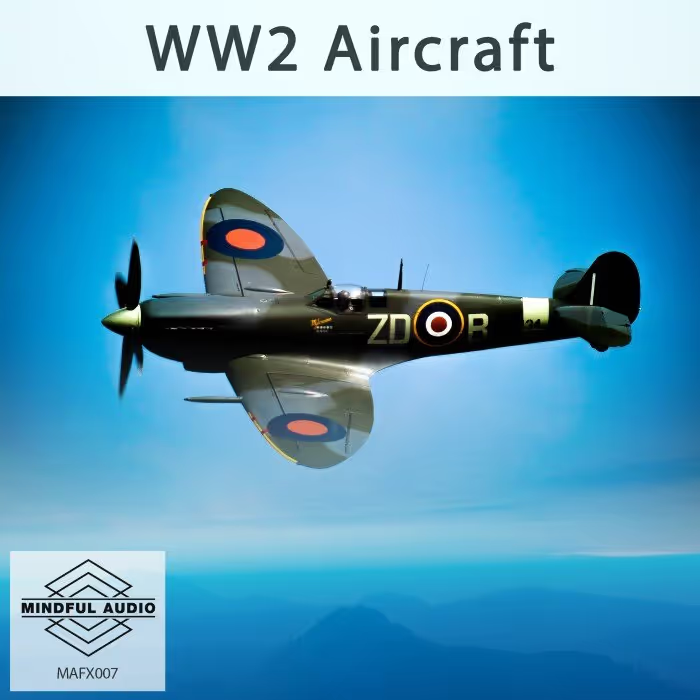The prospects of cloning have fascinated the human race since the late 19th century. But what if a person and their clone couldn’t exist simultaneously by law? Which one gets the right to live?
In director Riley Stearns’s film Dual – which ran in US Dramatic Competition at Sundance 2022 – that decision is made by a government-mandated fight to the death. The film follows Sarah, who decides to clone herself after being diagnosed with a terminal illness. But, Sarah miraculously recovers and now faces a death match with her clone.
Dual was acquired by RLJE Films, and there are plans for a theatrical release later this year.
In terms of sound, director Stearns wasn’t looking for a sophisticated tech-dominated Black Mirror-type future, but more like a left-of-center Yorgos Lanthimos-type future which is almost like our reality but not quite.
Here, sound supervisor Nelson Ferreira and sound designer Stephen Barden at Sounddogs in Toronto talk about creating the sound of Stearns’s near-future, how they used sound to support the story’s humanity, how music and sound design worked together, and more!
What were director Riley Stearns’s initial ideas for using sound to help tell this story? Were there particular scenes or sounds that he wanted you to tackle first?

Nelson Ferreira (NF): He had very specific ideas. Riley works with a very particular aesthetic. He knows what he wants in his films and he was very clear from the start. He pointed us to the last film he made, The Art of Self-Defense.
He had clear ideas not so much on what we were cutting but where we were cutting it. He spoke a lot about the tone of the movie.
Stephen Barden (SB): The great thing about Riley is that he has an existing relationship with his picture editor Sarah Beth Shapiro, who also cut The Art of Self-Defense and his previous film Faults.
Sarah had populated the Avid track with very definitive ideas about what Riley wanted the film to sound like. It was very well mapped out in the Avid; that’s always great for us as we get an idea of the types of things that he’s hearing in his head.
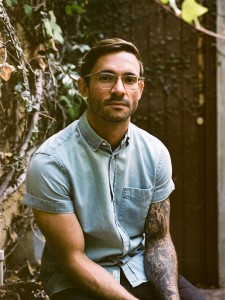
The opening scene shows two people on a football field in a fight to the death — it’s a guy named Robert and his clone. Does the fight sound over the top? Or sonically understated? How does the tone of this opening fight cue the audience into what they can expect for the rest of the film?
SB: In terms of how the tone of this fight cues the audience into what the rest of the film will sound like, Riley said to us during our spotting session that he doesn’t want the audience to know what the rest of the film is going to be like from that opening sequence, because that opening is unlike anything that’s in the rest of the film.
All the references to the duel that is ultimately going to happen — or is predicted to happen in the film — are vague and always about what could happen in the future. So those first five minutes of the film, Riley very much wanted to set the audience up, so they don’t know if this is going to be a big action film, or a really gory film. They wonder, “Who are these characters at the beginning of the film? Are they going to impact us later on?”
That opening sequence — as fun as it was to cut and as moody as it is — is not necessarily indicative of what the rest of the film is going to be like. That’s purposeful.
That opening sequence — as fun as it was to cut and as moody as it is — is not necessarily indicative of what the rest of the film is going to be like. That’s purposeful.
NF: I had read the script for the film way before we started so by the time we saw the cut, the script was cold in my memory. As the film started, I thought, “Wait? Is this the script that I read?”
It wasn’t the same movie that I remembered reading. It felt like it had a Logan’s Run kind of vibe, in terms of being a violent, futuristic movie.
But that’s not necessarily what it is.
SB: The Logan’s Run reference is really good, but that’s probably more on the sci-fi side. But still, you’re watching this opening five minutes thinking, “What is going on?”
NF: There’s a clean, cold futurism about it that is cool. And that feeling maintains itself through the movie.
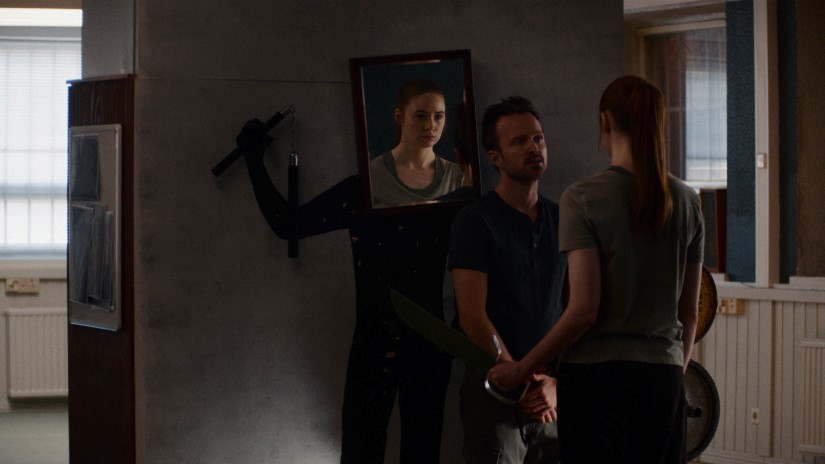
Later in the film, Sarah (the main character) employs a trainer to help her prepare for her own fight against her clone. There’s a moment that journalist John Defore of The Hollywood Reporter describes as a “slow-motion battle with a variety of weapons, each [character] narrating imaginary wounds as they are inflicted.” What does that mean in terms of sound?
SB: This trainer is trying to get Sarah into the best fighting shape possible because she’s not exactly a specimen of great athletic prowess at the beginning of the film.
The film is really about how we find meaning in our lives and connections in our lives despite the fact that we all face certain death.
So this fight between Sarah and her trainer is exactly as described; it’s almost like a dance. The instructor would tell you to put your right foot forward and then put your left foot back, and then turn this way. It’s choreographed and narrated by each character very specifically as to how that fight would be unfolding.
NF: The film is really about how we find meaning in our lives and connections in our lives despite the fact that we all face certain death. This is the movie Riley made. It does have a futuristic setting to the extent that it does happen five minutes in the future, and it deals with futuristic kill-or-be-killed scenarios, but that’s really just a metaphor for something else. This is a movie about relationships and meaning — about what our life here means to us.
Five minutes into the future and just to the left of our world, that was how Riley described it in our spotting session.
SB: Five minutes into the future and just to the left of our world, that was how Riley described it in our spotting session. I thought that was really great direction.
[tweet_box]Sundance: Designing the Dark-Comedy ‘Dual’ – with Nelson Ferreira and Stephen Barden[/tweet_box]
What does “five minutes into the future and just to the left of our world” sound like?
SB: Ultimately, it’s a really quiet film, with the exception of those opening five minutes. But even those (although slightly bigger and bolder) are fairly quiet compared to other films that might have the same premise.
…quiet films are the hardest to do because you have nothing to hide behind. Every single sound is right out there and exposed.
Otherwise, the film is very quiet. The detail is in the subtle choices of sound in the background soundscape, and the foley choices that were made. It’s a really quiet track. And those are the toughest tracks to make. Nelson and I have worked together for 25 years now and we always say that quiet films are the hardest to do because you have nothing to hide behind. Every single sound is right out there and exposed.
NF: This film is unique for that. There is an “otherness” to how things sound in this. The choices for sound are very sophisticated and the sounds are right out there. The film is so quiet that when you hear an effect, it’s there. It’s a character.
The sound choices all around were so sophisticated in their otherness, in that they felt recognizable but there was nothing cliché about them.
Out of necessity because of COVID, the film had to shoot in Finland. So a happy accident of that is that all the secondary acting roles were played by Finnish nationals who lived there. They all speak English very well, and phonetically it’s very similar to English, but it’s different. It has this neutral accent that isn’t easy to place. But it gives this left-of-reality flavor to the dialogue. It makes you wonder who these people are and where this place is because there is no city named, and no street signs — nothing to indicate where this happening. And the sound plays the same way.
The sound choices all around were so sophisticated in their otherness, in that they felt recognizable but there was nothing cliché about them. There was a unique and strange quality about the sounds that just fit into that world. It’s recognizable as a real-world sound but there is just something strange about it. The placement of the sounds, as well, contributed to that.
What scene best represents your sound work on Dual? Or, do you have a favorite scene for sound?
SB: As part of her training, original Sarah is sent to a morgue by her trainer because her trainer wants Sarah to get comfortable with the idea of death and what death does to a body. The morgue — as all morgues are — is in some third sub-basement of a hospital, which itself has a wonderful ambient sound design. Big credit to sound effects editor Ryan Allam who cut background sounds for me; he did a brilliant job of designing the atmosphere and ambiance.
Big credit to sound effects editor Ryan Allam who cut background sounds for me; he did a brilliant job of designing the atmosphere and ambiences.
We get into a very quiet area and the door to the morgue is (for some reason) a giant 6-inch thick metal door that sounds like a bank vault when it opens. When we go into that room it’s very quiet. And the reason the silence is so poignant is that the coroner starts to perform an autopsy by cutting open the torso of the deceased. The coroner cuts into the sternum and retracts the ribs. All of that is built with great sounds that are made so much more poignant because of the fact that the rest of the scene is so quiet.
In a masterstroke of the music mix, done by Mike Woroniuk (re-recording mixer), the music takes over and comes out of that moment. It’s very unsettling because we know that original Sarah has never seen anything like this and probably isn’t ready to see it quite yet. We’re very much sent into her inner perspective in that moment.
The sound design gives the scene a sense of chaos and incredible despair.
Another scene — completely different but also very fun — was at the end of Act 3. One of our characters is driving alone, and they’re in a traffic circle and experience a mental crisis. They come to a stop and all of this traffic is moving past them, whizzing past them eventually, and a great deal of chaos ensues in that moment.
That was fun to design because the camera is pretty much still and tight on the character almost the entire time. The sound design gives the scene a sense of chaos and incredible despair.
NF: If you’re really tuned into the movie, this scene is us showing our hand. And that’s fine; you can appreciate it. And if you don’t notice, then it works on a subconscious level in terms of creating discomfort for the viewer.
One scene that comes to mind for me is near the beginning of what I’d call the final act. We’re introduced to a forest.
The score has a dark metallic edge to it and it has such great impact especially when they lean into it.
Emma Ruth Rundle was the composer for the film. She’s an ambient-folk musician based in Portland. We’ve done plenty of films where there’s always talk of meshing design and music, yet I don’t remember the last time it worked as successfully as it did on this film.
It’s evident in that scene where we enter the forest. The score has a dark metallic edge to it and it has such great impact especially when they lean into it. And they do lean into it at times as a paradox to really quiet scenes. It’s shocking at times, the instrumentation choices and how dark and heavy it is.
There is a point in this scene where it’s being played with these lovely forest sounds. It sounds pretty much like straight-up forest effects, whether that birds or creaking trees or wind. But the choice of effects is so elegant that they feel like a piece of instrumentation in a modern piece of ambient music especially put against Emma’s score. It’s a gorgeous scene. You can’t distinguish between what Ryan and Stephen have done with the effects and what Emma has done with the score. And that’s the best outcome you can hope for.
But the choice of effects is so elegant that they feel like a piece of instrumentation in a modern piece of ambient music especially put against Emma’s score.
SB: That’s a great scene. From that point to the end of the film, because we do come back to the forest again, that whole design works so well together.
There are a couple of other places like that throughout the film when the ambient design of the sound effects and ambient design of the music work hand-in-hand. It’s always fun when that does actually work — it doesn’t always, as we know.
We had the advantage of hearing what was going to be happening with the music when we were cutting our sounds.
A lot of the temp music track was Emma’s music so, as we were cutting, that was already in the Avid because Emma had been providing sketches to Sarah (picture editor). We had the advantage of hearing what was going to be happening with the music when we were cutting our sounds.
NF: The editorial in this movie is so polished – the beats are so well thought out that so much of the music and effects placeholders were there in the Avid. To Riley’s credit, he really had a map of how the sound was going to work, and the timing of the movie was there. The music was integral to that and we got to paint over that, respecting those beats.
In spite of everything we’ve just said about Dual, make no mistake that this is indeed a comic movie as well. It’s a comic movie and so there’s timing, but it’s on a different clock than other comic films. It’s a slow, plodding clock. The music definitely plays to that time and we just hopped on for the ride.
So, it’s a comedy in the way that Yorgos Lanthimos’ The Lobster was a comedy? It’s not a Tommy Boy-type film, right?
NF: The Lobster is an excellent comparison. In fact, when we were talking with Riley about the types of movies he liked, he did mention The Lobster and other Lanthimos films.
Dual is a film that could easily be a double-feature with The Lobster. It would be apt to play both movies at the same festival. There is this “otherness” that both films share.
The dark absurdity and sad truths stated in the film, that’s what makes it funny.
SB: It’s a darkly comic movie that has a very unique sense of timing to it.
NF: It’s not that there are jokes to make you laugh. The dark absurdity and sad truths stated in the film, that’s what makes it funny. You laugh and shake your head at the same time.
In terms of sound, how was Dual a unique experience for you?
NF: For me, it was doing the entire film remotely. I mean entirely.
There have always been components of that in projects we’ve worked on the past couple of years, but there has always been some degree of face-to-face collaboration — being in the same room.
It was put together in such a low-fi, DIY way but it worked. It wasn’t just passable either; it’s slick.
This was the first project that we did everything remotely, even to the extent that the majority of the ADR (with the exception of Karen Gillan who played Sarah) was all shot on people’s iPhones. It was put together in such a low-fi, DIY way but it worked. It wasn’t just passable either; it’s slick. And we never shared the same oxygen as Riley Stearns throughout the whole process. It’s a chilling view of a near future.
SB: I concur. I was never even on the stage for the mix. I would sit in my studio and the re-recording mixers — Paul Shubat and Mike Woroniuk — would Zoom or Google Teams me if they had a question or needed something during the pre-mix. They’d play things for me that way so I could hear what they needed. I’d put something together here in the studio and send it to them on the stage.
We spotted the film over Zoom. Notes went back and forth between Riley and me by way of me sending him stereo crashdown premixes from Pro Tools. Riley is technologically savvy so I didn’t have to send him QuickTimes. I could just send crashdowns of my premixes and he’d bring those into his NLE (Avid or Premiere, I can’t remember what he was using). He’d give me notes back and that was done remotely. Approvals happened really quickly in that regard. The same happened during the final dub; I worked in my studio at home and waited for notes to come in.
A big thanks to Nelson Ferreira and Stephen Barden for giving us a behind-the-scenes look at the sound of Dual and to Jennifer Walden for the interview!

